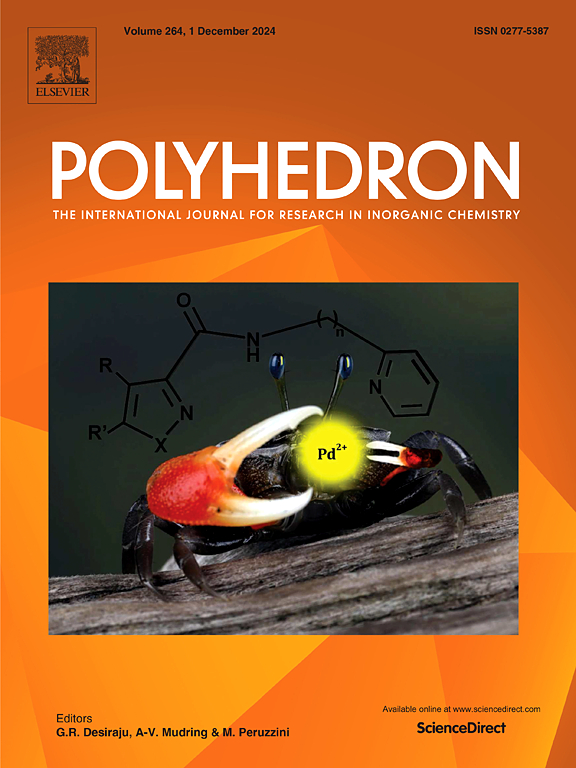四苯基膦/多硫化物混合物的合成及其温度诱导的可切换 WORM/flash 电存储器行为
IF 2.4
3区 化学
Q2 CHEMISTRY, INORGANIC & NUCLEAR
引用次数: 0
摘要
创新型非易失性存储材料的开发对于下一代高性能存储设备的发展至关重要。本研究合成了一种混合材料 (Ph4P)2S7,单晶结构分析表明有机四苯基鏻阳离子 (Ph)4P+ 采用规则的四面体构象,并通过 CH---π 相互作用形成一维链。(S7)2- 阴离子具有准双心对称性和右手螺旋簇的特点,被限制在有机基质中由 (Ph)4P+ 阳离子链建立的一维量子阱内。通过旋涂技术制造出了一种由 FTO/(Ph4P)2S7/Ag 组成的器件,该器件在温度诱导下具有显著的可切换二元写入-一次读取-多次写入(WORM)/闪存电记忆行为。在室温下,该材料表现出非易失性二进制 WORM 型电阻开关行为,开关比为 1.95 × 103,起始电压为 1.01 V。反之,在 150 ℃ 时,它过渡到二进制闪存型电阻开关行为,电流比为 3.34 × 102,起始/复位电压为 1.05/-1.99 V。此外,在高温下观察到的 WORM 型和闪存型电子存储器行为之间的可逆转换可归因于 (Ph)4P+ 阳离子在高温下的晶格膨胀,从而导致有机分子堆积更密集,活性层内的电子捕获势阱更深。这项研究为开发新型高性能信息存储材料提供了理论依据。本文章由计算机程序翻译,如有差异,请以英文原文为准。

Synthesis of tetraphenylphosphonium/polysulfide hybrids and their temperature-induced switchable WORM/flash electrical memory behavior
The development of innovative non-volatile storage materials is essential for the progression of next-generation high-performance storage devices. In this study, a hybrid material (Ph4P)2S7 was synthesized, and single crystal structure analysis demonstrated that the organic tetraphenylphosphonium cation (Ph)4P+ adopts a regular tetrahedral conformation and forms one-dimensional chains through C![]() H···π interactions. The (S7)2- anion, characterized by quasi-bicentric symmetry and a right-handed helical cluster, is confined within the one-dimensional quantum well established by the (Ph)4P+ cation chain in the organic matrix. A device composed of FTO/(Ph4P)2S7/Ag was fabricated through spin-coating, demonstrating remarkable temperature-induced switchable binary write-once-read-many-times (WORM)/Flash electrical memory behavior. At room temperature, the material demonstrated nonvolatile binary WORM-type resistance switching behavior with a switching ratio of 1.95 × 103 and an onset voltage of 1.01 V. Conversely, at 150 °C, it transits into binary Flash-type resistance switching behavior characterized by current ratio of 3.34 × 102 and onset/reset voltages of 1.05/−1.99 V. The mechanism underlying binary resistive switching is identified as spatial charge-limited charge capture. Furthermore, the observed reversible transition between WORM- and Flash- type electrical memory behavior at elevated temperatures can be attributed to lattice expansion of the (Ph)4P+ cations at high temperatures, resulting in denser packing of organic molecules and deeper trapping potential wells for electrons within the active layer. This study provides theoretical insights into developing novel high-performance information storage materials.
H···π interactions. The (S7)2- anion, characterized by quasi-bicentric symmetry and a right-handed helical cluster, is confined within the one-dimensional quantum well established by the (Ph)4P+ cation chain in the organic matrix. A device composed of FTO/(Ph4P)2S7/Ag was fabricated through spin-coating, demonstrating remarkable temperature-induced switchable binary write-once-read-many-times (WORM)/Flash electrical memory behavior. At room temperature, the material demonstrated nonvolatile binary WORM-type resistance switching behavior with a switching ratio of 1.95 × 103 and an onset voltage of 1.01 V. Conversely, at 150 °C, it transits into binary Flash-type resistance switching behavior characterized by current ratio of 3.34 × 102 and onset/reset voltages of 1.05/−1.99 V. The mechanism underlying binary resistive switching is identified as spatial charge-limited charge capture. Furthermore, the observed reversible transition between WORM- and Flash- type electrical memory behavior at elevated temperatures can be attributed to lattice expansion of the (Ph)4P+ cations at high temperatures, resulting in denser packing of organic molecules and deeper trapping potential wells for electrons within the active layer. This study provides theoretical insights into developing novel high-performance information storage materials.
求助全文
通过发布文献求助,成功后即可免费获取论文全文。
去求助
来源期刊

Polyhedron
化学-晶体学
CiteScore
4.90
自引率
7.70%
发文量
515
审稿时长
2 months
期刊介绍:
Polyhedron publishes original, fundamental, experimental and theoretical work of the highest quality in all the major areas of inorganic chemistry. This includes synthetic chemistry, coordination chemistry, organometallic chemistry, bioinorganic chemistry, and solid-state and materials chemistry.
Papers should be significant pieces of work, and all new compounds must be appropriately characterized. The inclusion of single-crystal X-ray structural data is strongly encouraged, but papers reporting only the X-ray structure determination of a single compound will usually not be considered. Papers on solid-state or materials chemistry will be expected to have a significant molecular chemistry component (such as the synthesis and characterization of the molecular precursors and/or a systematic study of the use of different precursors or reaction conditions) or demonstrate a cutting-edge application (for example inorganic materials for energy applications). Papers dealing only with stability constants are not considered.
 求助内容:
求助内容: 应助结果提醒方式:
应助结果提醒方式:


